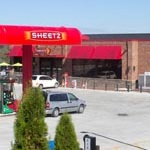At a Glance
Location
St. Louis
Founded
1957
Employees
More than 70,000
Specialties
Car-rental services and construction of rental stations
Annual Revenue
More than $14.1 billion
For most travelers, an airport rental-car facility is just a simple stop on a longer journey—one that they want to navigate as quickly as possible to get where they’re going. In their rush, it’s unlikely that any will take note of the vast amount of planning and design work that goes into achieving a positive rental-car experience, but Randy Kinsey, director of airport construction for Enterprise Holdings, Inc., is fine with this. The experience, as he and his team see it, is meant to be seamless.
Kinsey operates Enterprise’s internal department in charge of constructing and renovating airport rental-car locations. The company operates three distinct rental-car brands: National Car Rental, catering to business clientele; Alamo Rent-A-Car, targeting the leisure traveler; and Enterprise Rent-A-Car, a high “touchpoint” brand. “Our three brands offer very different business models and have different customer-delivery methods, so each facility must allow for those various expectations to be met,” Kinsey says. “Although there are similarities, we are not building the same thing over and over again—all of our projects are custom designed and constructed.”
Top 4 Challenges to Building Enterprise’s Airport Rental Stations
1. Meeting approval. The design of each location should enhance the customer experience, but at the same time it must comply with a wide range of construction regulations, including those of the airport.
2. Branding. Each Enterprise brand has a distinct customer, and each location has to be designed to a specific brand’s standards, with the goal of exceeding customer expectations.
3. Estimating size. Early and proper planning is essential to ensuring capacity is right for each location.
4. Constructing on active sites. Renovations to fully functioning spaces make up 80% of Enterprise’s work, so the challenge is to complete such projects with as little negative impact on operations as possible.
Throughout the United States, Kinsey works with more than 60 operating groups, all of them are wholly owned subsidiaries serving as an extension of Enterprise. His regionally based team of project managers directly oversees any and all renovations and new builds, with each manager juggling 15–20 projects in various stages at any given time.
Enterprise already has 260 airport rental locations on the books, and Kinsey says having in-house managers with a vested interest makes the most fiscal and operational sense as the company grows. “Besides the cost savings of not having to pay project-management fees,” he says, “since our team coordinates the same type of project day in and day out, we can easily apply what we’ve learned about what does and does not work to new projects.”
Kinsey bids out his department’s construction work, and bidding is usually limited to preferred contracting firms that work with Enterprise on a consistent basis. “Our facilities may just appear to be a parking deck or lot, but there’s a lot more to it,” Kinsey says. “Each facility is our retail space, and there are numerous design details and metrics that go into construction. The contractors we work with regularly understand what we do and the way we prefer to do it, which saves us time and money.”
Some of Enterprise’s design requisites include high ceiling clearances for vehicles, ample visibility, bright and direct lighting, properly designed entry and exit points, an appropriate size and number of parking spaces, and clear directional signage—all of which affect a customer’s experience. The company also designs to increase employee productivity; for example, it will often place fuel pumps beside vacuum stations to facilitate quicker car turnarounds.
Constructing on airport properties adds further levels of review and approval, particularly for a company installing fuel tanks and connecting to water supplies, so looking ahead, to maintain efficiency, Enterprise plans to bring consistency to its brands at every location through widespread renovations. To this end, Kinsey has completed manuals on construction specifications for each of Enterprise’s brands. These 1,000-page “play books” contain everything from narratives to reference drawings and are given to preferred contractors as another step in maintaining consistency. “As our brands continue to grow, these manuals will ensure standards are met,” Kinsey says. “In the future, I see the opportunity to carry this level of consistency into our global operations and our off-airport facilities as well.” ABQ


